I’ve been living in Mexico since 2010, and I mainly focus on the struggles of indigenous groups in Latin America and their ongoing fights to defend their territories and cultures. This collection is a result of spending extended periods within Santa Maria de Ostula and Cherán K’eri, two indigenous communities that are trying to enact social and environmental justice in the notoriously violent state of Michoacán in southern Mexico, where they face violent organized crime elements and government corruption.
These indigenous communities established two municipalities of semi-autonomous, grassroots governments in response to violence from organized crime, corruption from state and federal government, and environmental degradation from international mining and tourism. Their claims to the right to self-determination are based on Article 2 of the Mexican Constitution. This clause allows indigenous towns to govern themselves in traditional means that fall outside of the institutionalized Mexican political system. These communities established their own local grassroots governments and security forces to defend their borders, secure peace, enact environmental and social justice and preserve important elements of their cultural heritage.
These movements, initiated by Mexico’s most dispossessed and marginalized populations demonstrate their capability to find their own solutions to some of humanity’s most pressing problems: crime, lack of education, disappearing cultural heritage, environmental degradation and corruption.
Working in these two municipalities has been inspiring. In both of the countries I call home (the U.S. and Mexico) there is widespread cynicism about government and its abilities to adequately reach its citizens.
In these indigenous communities, the local grassroots governments must respond to its constituents as they are often neighbors and/or family members. Public servants and government representatives literally see the people they serve on a daily basis. This often takes political action into both public and private spaces where one can regularly experience residents engaging and discussing which actions will further benefit the community. This proximity of the communities to their governments leaves little room for apathy and cynicism among constituents. Although these towns are not utopias by any means, there is a palpable pride among the communities.
In both municipalities, I had to gain the trust of the people. In Santa Maria de Ostula, I actually had to present my project idea to the entire community in an assembly of over 1,000 people before they voted on whether to grant me access. Luckily, I persuaded them and they granted me access. Immediately my face was known to everyone and I was able to move freely within the community.

In the town Cherán K’eri of the Meseta Purépecha in the mountains of Michoacán, the culturally indigenous population has established an autonomous government which celebrates the town’s cultural and traditional identity. This is a traditional wedding celebrated and planned by a young couple. Before the movement, these types of weddings were becoming less common. Now, the traditional weddings have seen a resurgence.

A young community member clears land in the town of Ostula. The town lent him the land for the following season’s planting of new papaya crops.

Agricultural production in Ostula is carried out in the same way for hundreds of years. Here, a local campesina crosses the great Ostula River with her donkey to collect seven watermelons from her farm — a three-hour hike up a mountainside each way.

Cherán’s leaders have promised to invest in the youth of the town by offering them regular bilingual classes in both the Purépecha and Spanish languages. The number of community members who speak Purépecha fluently are dwindling. Purépecha, for the new movement, has become more prestigious and seen as an important part of the region’s culture. So far, the investment has been easier said than done. Fluent Purépecha speakers with formal education and the ability to teach a non-necessary second language are few and far between. Today, the youth are not learning much more than phrases and words. But, the will is there and Cherán is determined to continue making it a priority.

Seventeen-year-old Paula Lopez and her team from Mexico City lights her massive unmanned hot air balloon creation during Cherán K’eri’s annual hot air balloon festival and competition. She and hundreds of competitors travel from around the country to take part in the event. The competition is organized by the autonomous government in order to keep local indigenous and regional traditions alive and well. Shortly after she lit her 70-foot-high massive balloon, she won the grand prize in the contest. This event happens every August in Cherán K’eri.

Throughout the rainy season in Cherán K’eri, volunteers hike into the devastated forest that was illegally logged for years by organized crime syndicates; they hope to replant and reforest the decimated areas. Cherán volunteers do the planting under the watch of community security forces because there have been gun battles with organized criminals in which community members have been killed.

Emilia Garcia Cabrera, the mother of Eriberto Reyes Garcia — a boy who was accidentally killed by the Mexican military during a peaceful protest — collapses on her son’s grave during the second anniversary of his death.

Here in Palma Sola local community members welcome the Virgin of Guadalupe of Ostula to their town with a syncretist religious procession that mixes both indigneous and European Catholic elements. These traditions are part of the culture and history that they are protecting with their social movement.
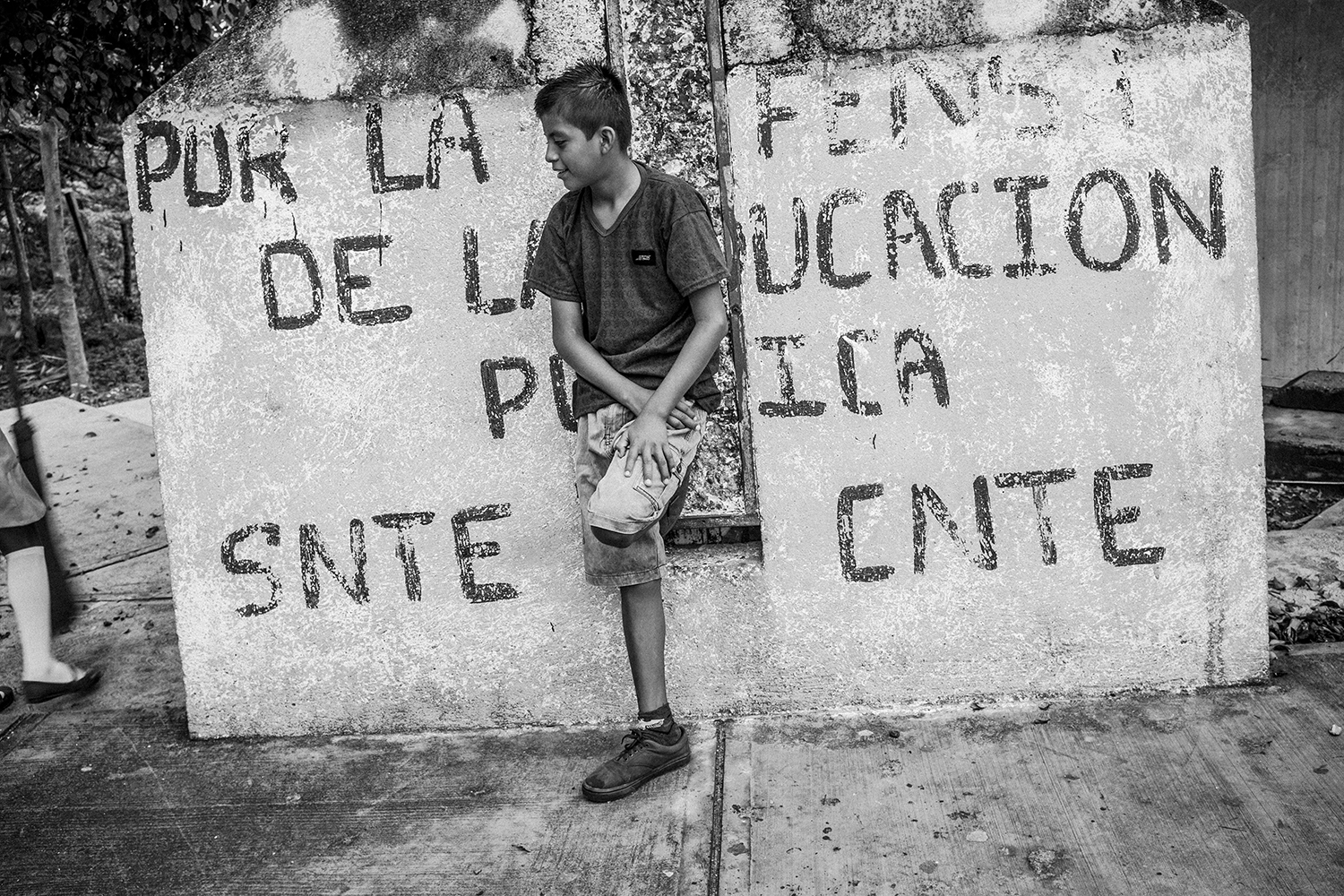
In a public school, a student rests in front of a sign put up by the country’s most powerful teacher’s and worker’s unions. Although these towns are functioning under their own semi-autonomous governments and security forces, they still see themselves as part of Mexico. But the traditional Mexican political system and political parties are secondary to the influence and power of the local grassroots government.

Young girls play in an abandoned bus while the adults of the town attend their monthly local governmental meeting.

In the courtyard of their local school in La Ticla, Ostula, students salute the Mexican flag in their daily flag ceremony. Although they do not belong to the institutionalized Mexican political system, residents of Santa Maria de Ostula still identify themselves as Mexicans; they are constitutionally granted the right to govern themselves under the “usos y costumbres” article of the Mexican Constitution.
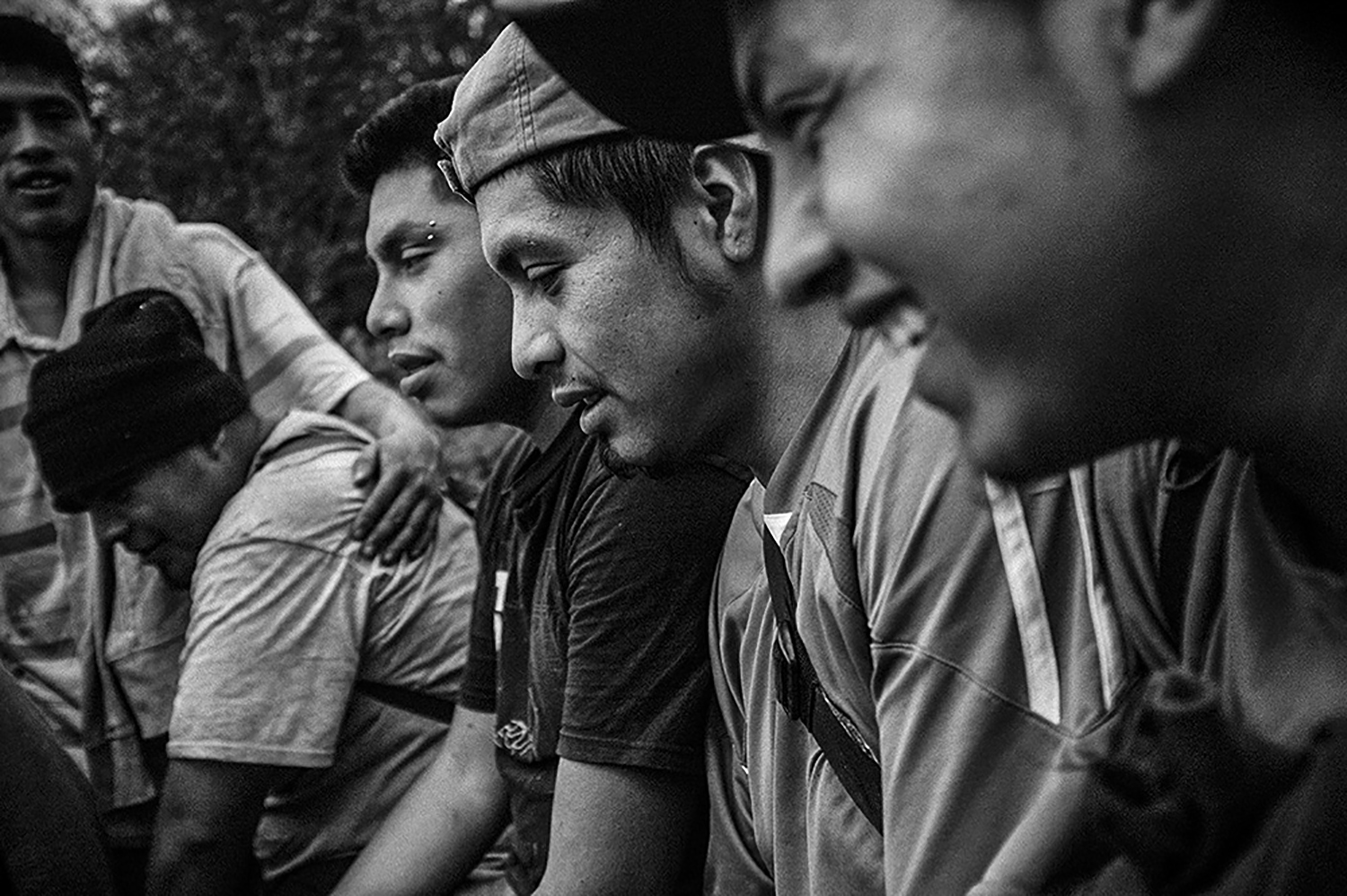
Cherán K’eri volunteers return from work in the evening after spending the day replanting trees in a forest where violent illegal loggers have protected their business, even killing volunteers.

Comeí — community leader, social activist and security leader — checks out a gun of the town’s security forces in front of his son and his friend. Growing up in the Mexican countryside, children are unfortunately regularly around guns.

Jota Nativdad is a resident of La Ticla in Ostula. He’s been farming the land that the community lent his family since he was a child. Just a few years ago, he says he was forced to work by armed men and he had to keep his head down, and go to and from his plot of land on the beach. “There’s no way to live,” he told me. “We’re proud people.”
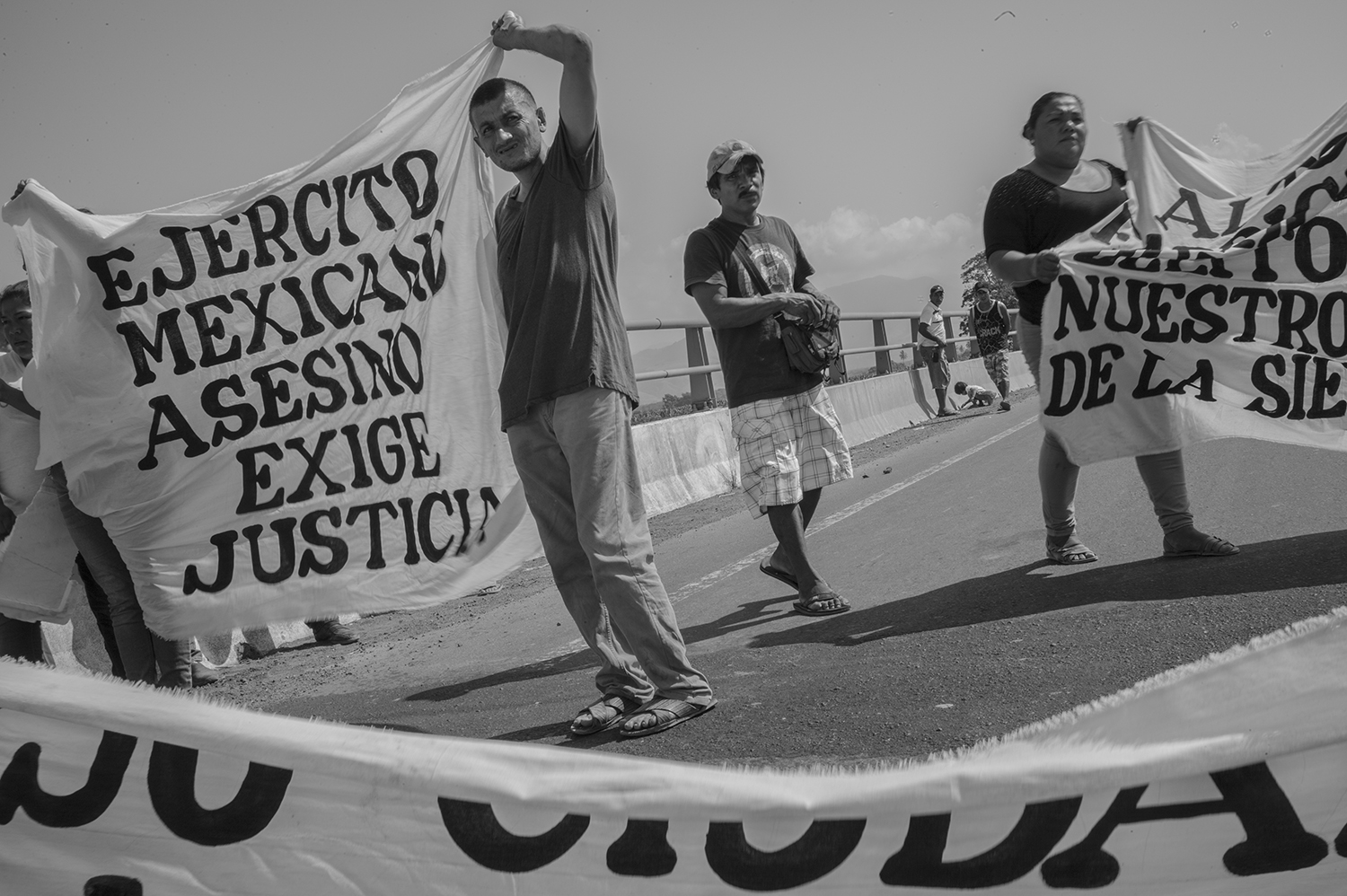
Local members of Ostula, combined with other communities of the coast of Michoacán, close down a major bridge in protest. Their goal is to stop commercial trucks moving along the coastal road in order to pressure the government to respond to their demands. The legible banner reads “The Mexican military is an assassin. Demand justice!”

Security forces at the northern barricade on the coastal highway. These security forces secure the town’s entrances and exits and filter who can enter. Most of their guns were taken from the organized crime elements that were ejected from the area as the indigenous movement began.
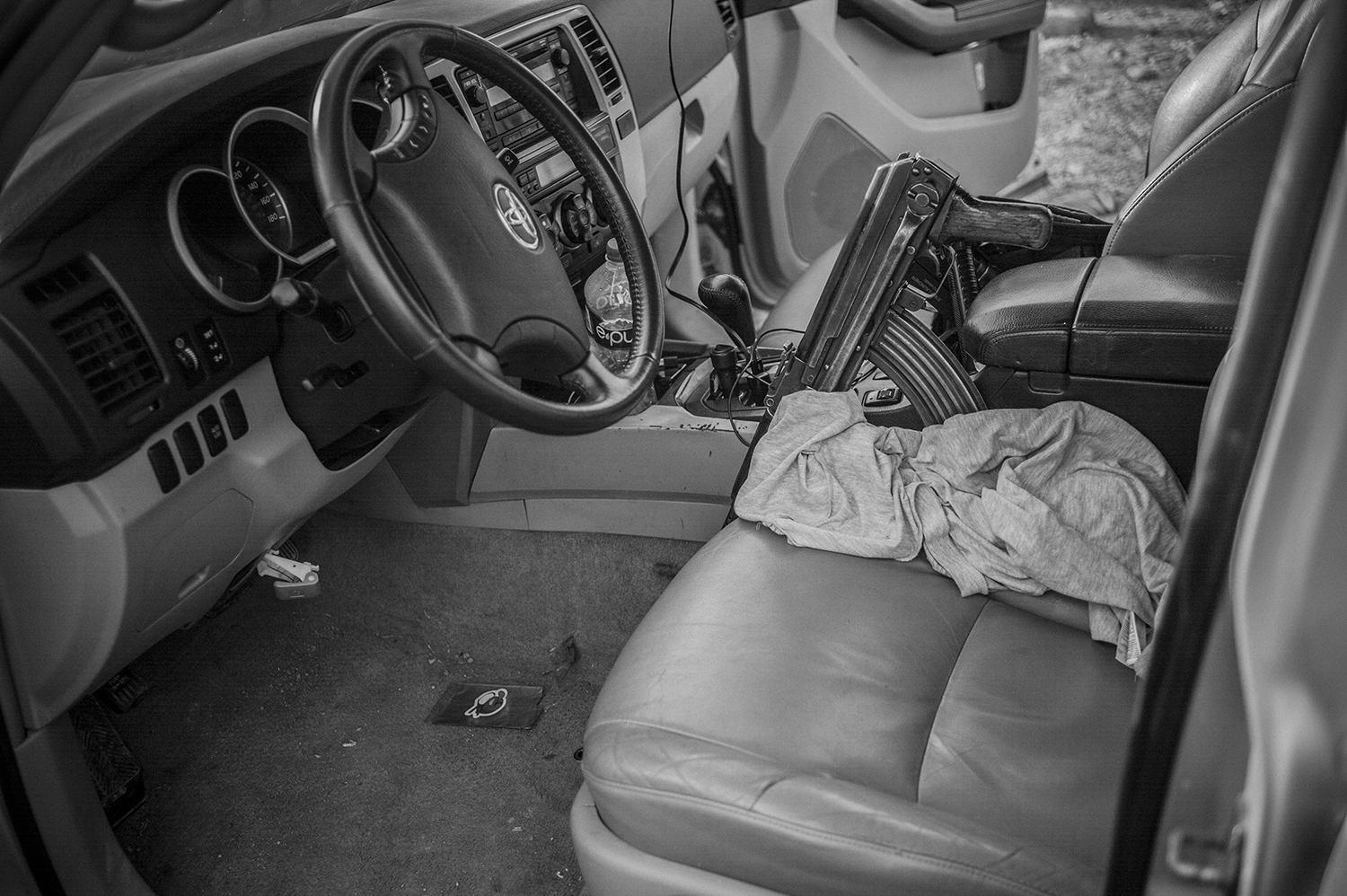
The interior of the personal truck of one of the community leaders of Ostula. Security forces and community leaders must travel armed and protected in order to keep themselves and the community safe from the interests that wish to topple their social, political and environmental movement.

“El Gavilan” (the Hawk) is a member of the security team that works with the municipality of Ostula, Here he is on guard at the small town of Xayakalan at the northern most border of Santa Maria de Ostula.

The land is not the only territory the members of Ostula are trying to protect. They also have virgin coastlines that they regularly fish. The ample sealife has allowed the towns along the coast of Ostula to fish and supply themselves with enough food to eat and sell to other towns. The coastline is coveted for tourism development. Here, local fisherman Tomas prepares his lines to head out to see by night.

The vast coastline and the plains in Ostula are used for community get-togethers, farming and sports. Pictured, a Sunday afternoon soccer game between two towns within the municipality of Ostula.

Local young members of the community socialize at an afternoon soccer game held on the coastal plains of the vast territory of Ostula.
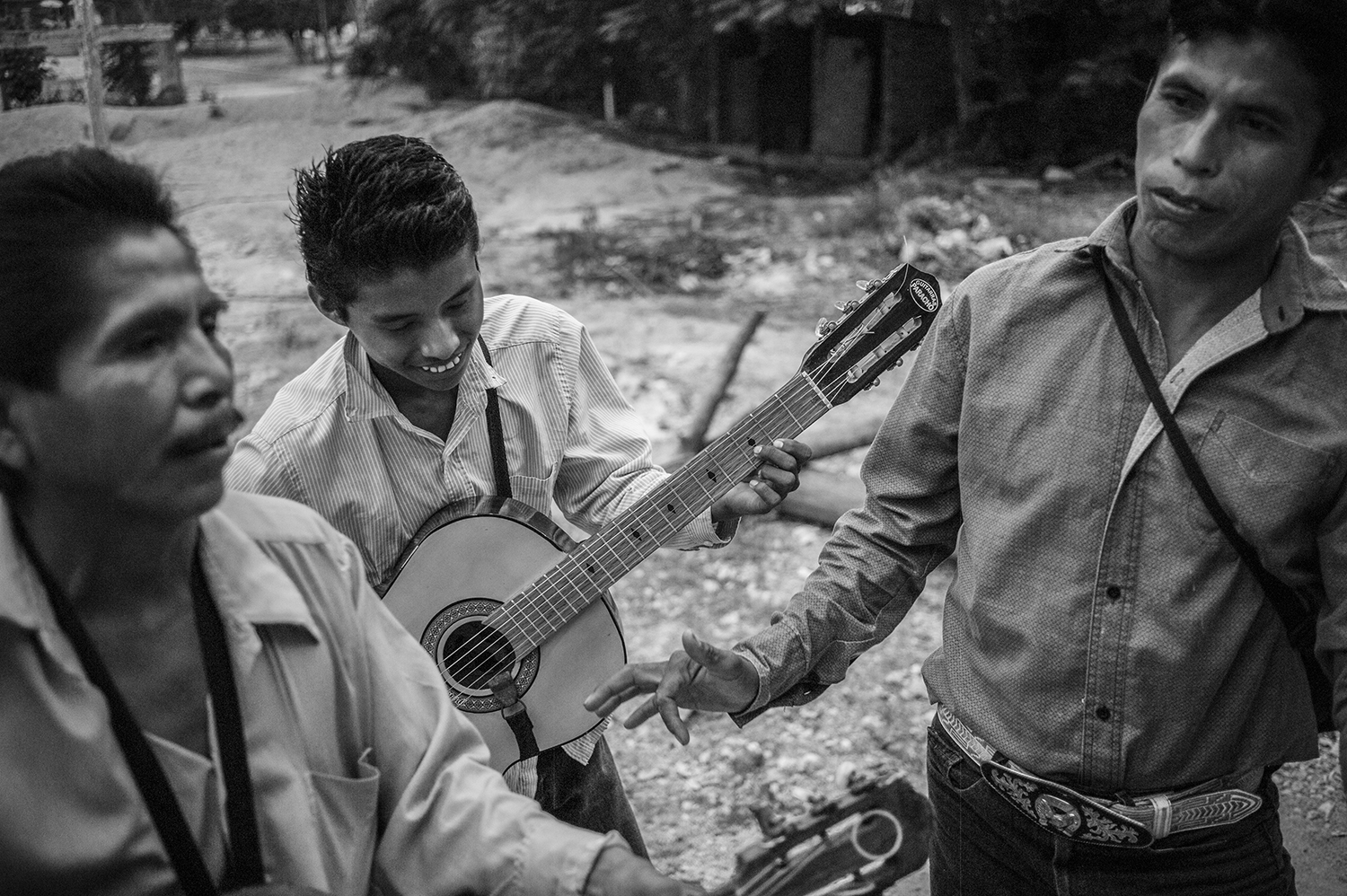
Local musicians play music unique to the region at a quinceñera. The region is rich in cultural traditions that the communities are fighting to preserve.

These towns deal with many local security issues. Here is a local man locked up in a makeshift prison for an offense.
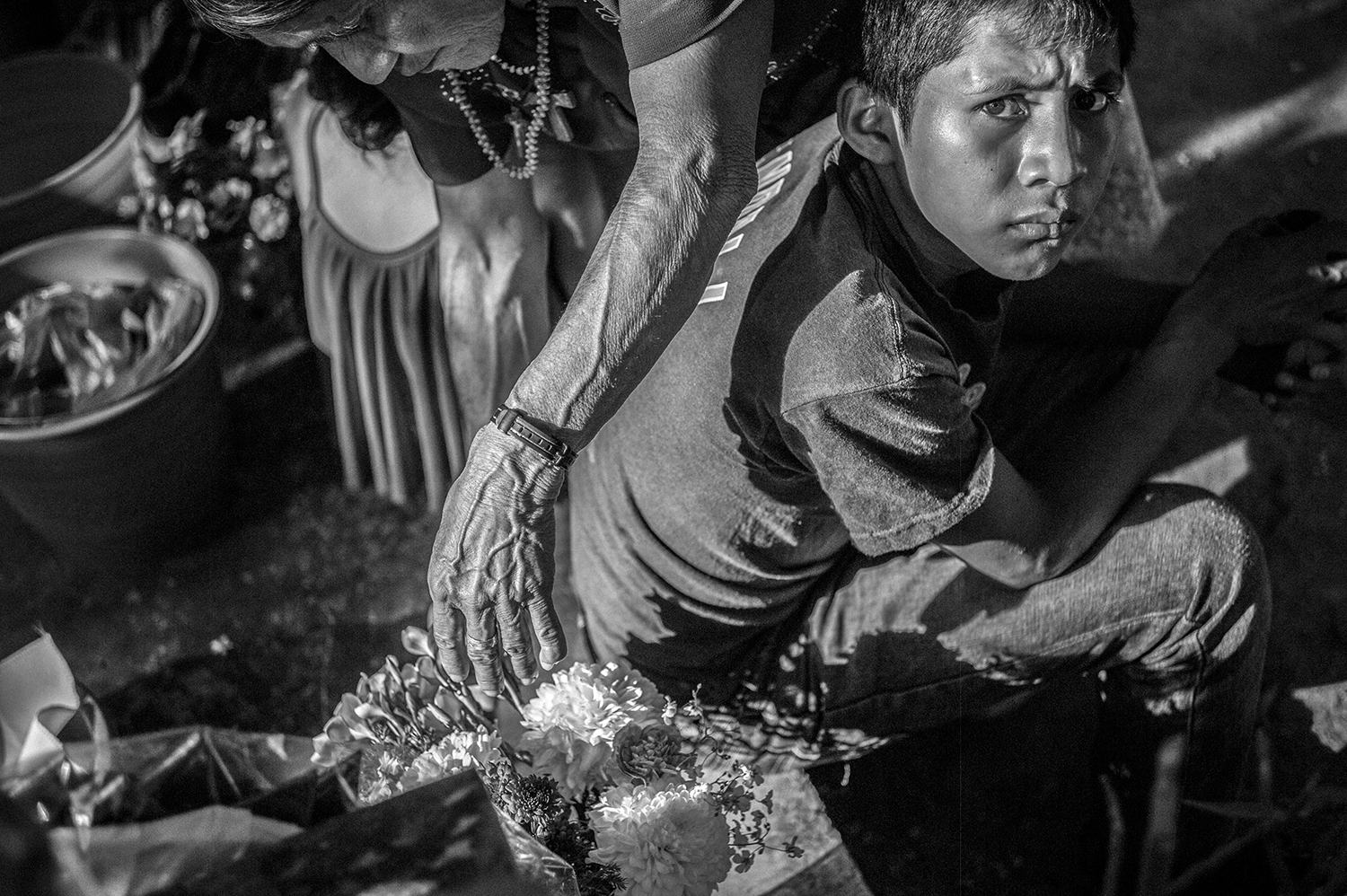
Day of the Dead celebrations in La Ticla, Ostula, in 2018. This elderly woman told me that the Mexican government loves bragging about its indigenous cultures. She claims that when indigenous people sell their jewelry on the street corner in their traditional garb, the government is happy and proud to speak about their indigenous cultures. But when indigenous peoples demand their rights and defend their territories, the government turns to hostility.

Local fisherman in Ostula prepare the motor that will pump their oxygen as they scuba dive with a makeshift hose to depths of ten meters. The soda bottle holds the gas.

The local schools in Ostula are still subsidized by the federal government, but Ostula is incorporating indigenous cultural and social-political histories into the classrooms. Most recently, they have been attempting to teach bilingual Nahuatl classes. This is a challenge for most Mexican schools that wish to keep their native languages alive.

Onlookers observe the preparation of the ancient local indigenous street festival theatre of xayacates in Santa Maria de Ostula.

Soccer is a common way of socializing throughout Mexico. For the indigenous region of Ostula, it’s a way of interacting and socializing outside of the vast territory. Here is a celebration immediately outside of the Ostula territory in La Placita, a largely Mestizo town.

A young man who wished to remain anonymous mans the checkpoint at Xayakalan, the the northern most border of Ostula. Local community members ages 17 and older have to do their service protecting the town’s border from organized criminal elements.

The indigenous region of Ostula is largely independent because of its subsistence farming and hunting traditions that have remained largely unchanged for hundreds of years. Here, where the Ostula River empties into the Pacific Ocean at the town of La Ticla, community members fish tiny fish locally called gardumo which make an appearance in the river only about five times per year. This river is the life line of the community. Many residents worry that if mining companies and hotels topple the autonomous movement, the lively river will be contaminated, as has been the case with other rivers of similar size in Mexico. This river mouth also has helped form a great surfing pointbreak, visited by the occasional international tourist and surfer from nearby Guadalajara.

Marco Antonio is a young man starting his family in Ostula. He is an active member in the political and social life of the community and hopes to see his family continue to live in peace.

Joakim is an elder of Ostula from the town of La Cobanera. Joakim grew up speaking Nahuatl, the language of the Aztecs, and the waning indigenous language of the region. When he was a child, Nahuatl was officially discouraged in favor of Spanish. Today, local officials from the resistance-autonomous movement have asked Joakim how he can help resurrect the use of the language in schools. Unfortunately, these elders are not literate in Nahuatl, nor are they trained as educators. Many of the bilingual programs that attempt to reclaim the linguistic heritage fall short due to these common shortcomings.

From July to August, Cherán gathers volunteers to hike into the forest — where snipers have murdered community members — in order to plant new pine saplings in the decimated, deforested areas. Teenagers, elders and small children make the trek into the forest protected by heavily armed guards on horseback, to reforest the areas that were cut down. Comunero (community member and movement supporter) Miguel Geronimo told me, “What we’re doing here will be well worth it someday soon. Our children and grandchildren will once again have shade to play in and trees to stare up at and dream into.”

In the coastal town of La Ticla, Ostula, students learn English in a rural high school on the coast of the Pacific Ocean. World-class surf breaks in front of the school and fertile communal lands are harvested using technology hundreds of years old. These virgin beaches are sought by international tourism companies, organized crime syndicates for product shipment, and transnational mining companies. The autonomous movement based in territory defense has successfully kept these multibillion dollar interests away, for now.

In many of the towns within the municipality of Ostula, there are very few modern amenities. Part of the social movement’s goal is to preserve these ways of life against modernization. Here, a family from the town of El Dun bathe in a local river during the week as the town goes at times weeks without running water.

In Santa Maria de Ostula, every September 10 and December 13, the indigenous community carries out a centuries-old form of street theater that was brought from Spain to the region in the 16th century. When it arrived, the European battle between the Moors and Christians was mixed with indigenous cultural elements to form a syncretist tradition that exists today. Men dress as xayacates, ghost-like figures that represent an element of chaos and uncertainty — a physical manifestation of the rupture of social norms during war. These traditions — that are carried out only in Ostula — are an example of the cultural traditions that the indigenous movements in Mexico are trying to protect and preserve.

































